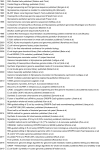Genome-driven cell engineering review: in vivo and in silico metabolic and genome engineering
- PMID: 31243142
- PMCID: PMC6610458
- DOI: 10.1042/EBC20180045
Genome-driven cell engineering review: in vivo and in silico metabolic and genome engineering
Abstract
Producing 'designer cells' with specific functions is potentially feasible in the near future. Recent developments, including whole-cell models, genome design algorithms and gene editing tools, have advanced the possibility of combining biological research and mathematical modelling to further understand and better design cellular processes. In this review, we will explore computational and experimental approaches used for metabolic and genome design. We will highlight the relevance of modelling in this process, and challenges associated with the generation of quantitative predictions about cell behaviour as a whole: although many cellular processes are well understood at the subsystem level, it has proved a hugely complex task to integrate separate components together to model and study an entire cell. We explore these developments, highlighting where computational design algorithms compensate for missing cellular information and underlining where computational models can complement and reduce lab experimentation. We will examine issues and illuminate the next steps for genome engineering.
Keywords: Genome Engineering; Metabolic Engineering; in-silico; metabolic models; whole-cell models.
© 2019 The Author(s).
Conflict of interest statement
The present study did not generate any new data.
The authors declare that there are no competing interests associated with the manuscript.
Figures






References
Publication types
MeSH terms
Grants and funding
LinkOut - more resources
Full Text Sources
Miscellaneous

